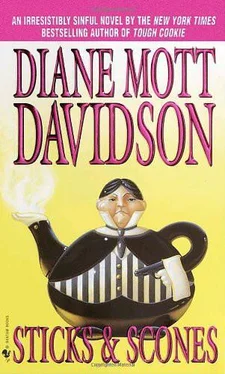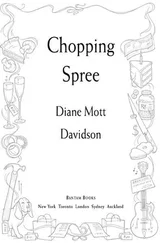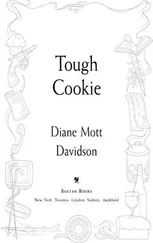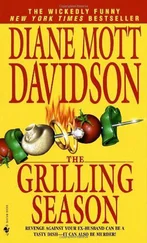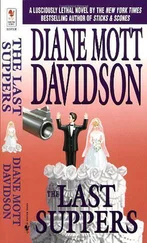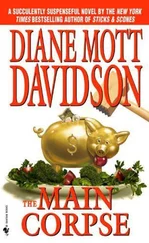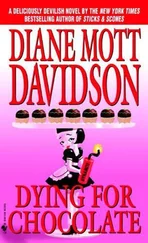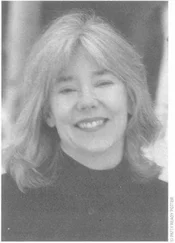Arch shouldered his pack, nodded a mature farewell to me, and told Michaela he’d meet her by the portcullis. He even managed to thank Sukie and Eliot before making his way out of the kitchen.
To me, Michaela said softly, “Eliot mentioned that someone took a shot at your house last night?”
“Yes,” I said. “The police don’t have any leads yet. But I took a call on my cell phone on the way over here. There’s something I need to warn you about.” All three faces became immediately curious. “My ex-husband, Dr. John Richard Korman, has just been granted an early release
from serving a sentence for assault. If he shows up here, please do not let him in. I’m checking on the status of a restraining order,” I added. “He’ll have to see Arch at some point, but we haven’t figured that out yet.”
Their questions tumbled out as I put the chicken and other perishables into the refrigerator: Was John Richard the one who’d shot at our window? Did he know I was here at the castle? Did he know how to get here?
“We have no idea what the man looks like,” Eliot mused, his voice concerned. “If we could have a photograph …”
“Yes, definitely, no problem,” I replied. “I’ll get one when I pick up the disk.”
The snow had stopped as Michaela, Arch, and I drove off. My van followed Michaela’s Elk Park Prep minibus down the slick, winding driveway. Her tires cut twin black tracks in the pristine trail of snowy pavement. Soon the minibus was out of sight.
When I came through the front gate and crossed the bridge onto the state highway, I remembered the rental tables that were supposed to be at Hyde Chapel. I pressed the accelerator, determined to see what was going on. Or not going on, as the case might be.
As I drove up the road, I punched the cell phone buttons for Tom’s Atlantic City motel, on the remote chance he was still there. The man who answered said Tom had left several hours ago. I then tried the main number for Furman County government and entered the buttons for Pat Gerber’s extension at the district attorney’s office. Of course, since it was not quite seven, all I reached was her voice mail. I left a message: My ex-husband got an early release from prison, and a bullet shattered one of our windows at four this morning. With a temporary restraining order in place, what was our next step for visits with our son?
I disconnected as the chapel bridge across Cottonwood Creek came into sight. Beyond the bridge, the chapel’s delicate gray spires and arched stained-glass windows looked ethereal in the soft morning light. After auctioning off the Henry VIII letter, Eliot had given the Gothic chapel to the church, to offset his tax burden. In order to make Hyde Chapel a tourist attraction clients would associate with the castle conference center, Sukie had directed an extensive cleanup, and paid Chardé Lauderdale handsomely to decorate the place. The labyrinth had been the crowning centerpiece of the renovation. Saint Luke’s had been thrilled.
This day’s lunch event had been covered in a fluff piece in the Mountain Journal and in the Saint Luke’s newsletter. Although the church had received lunch confirmations for twenty, the Episcopal Church Women had begged me to make enough food for up to ten more folks, for those donors untroubled by RSVP’s. The ECW was handling the loan of church plates, silverware, and crystal for the lunch. I’d merely replied to the ECW that lunch for thirty or even thirty-five would be no problem.
I swung the van across the chapel bridge, intent on finding the tables. With the bad publicity generated by the Lauderdale incident impacting my business, it was imperative that the lunch event go without a hitch. If the tables had not been delivered, I would call Party Rental at nine and deliver a blistering harangue. In the catering biz, sometimes you had to get rough.
No spotlights illuminated the chapel. I pulled into the gravel parking lot and swung around to park facing the creek, as close to the building’s carved front doors as I could get. Across the highway in Cottonwood Park, the sun lit the top of the thick cluster of pine trees.
As I sat with the van running, I tried to recollect the combination on the lockbox that held the chapel key. The chapel had been designed as a miniature of Chartres, and boasted some features of that enormous cathedral, including a rose window and, now, a labyrinth. I tapped the steering wheel and finally recalled that the letters on the lockbox combination were C, H, A, R, T, R, E, S. There was a Gothic-lettered sign to my right, at the top of the creek bank. Set your brake! it warned. Management cannot pull your car out of the creek!
I smiled at the vision of Eliot and Sukie towing a vehicle out of the water. I pulled up on the brake, then leaned forward in my seat to check how far I was from the creek. Fifteen feet below, the narrow chute of black, gurgling water raced between the icy banks.
I squeezed my eyes shut, heart pounding. I hadn’t just seen what I’d just seen. Or had I? Surely it had been an illusion, my sleep-deprived mind playing tricks with ice, water, stone, sunlight. You think you see something flesh-colored, something bobbing eerily in the water, and it turns out to be a rock.
I took a deep breath, jumped out of the van, and walked carefully to the edge of the creek bank. No, it wasn’t quartz, granite, or even mountain marble. In the creek was a blackened hand. A hand attached to an arm clothed in plaid flannel. A blackened hand? I stared into the water below. The rigid body of a young man lay half in the creek, as if he’d been tossed there.
I looked away, chilled. He needs help, my brain screamed. Help him. Get him out of that water!
I took a few tentative steps down the steep, boulder-strewn creek bank. Then I slid on a patch of ice.
Help him, get him out. But how could I get to him? I regained my balance and stared at the water. There were rocks in the creek itself, and a sheet of ice that might or might not hold my weight. Even if I got down there, was I strong enough to pull him out?
Now ten feet from the water, I caught sight of the young man’s scalp. What I had thought was thick hair was a dark splotch of blood. I blinked and tried to make out his facial features.
Hold on.
His photo had appeared at least a dozen times in the Mountain Journal. I’d heard his voice once, on the phone.
But he wasn’t supposed to be here. He was supposed to be hiding. In New Jersey. Where Tom was looking for him to question him about the FedEx hijacking. Not in Colorado. Not lying in Cottonwood Creek. Yet there was no doubt that Andy Balachek wasn’t gambling at a casino table.
Andy Balachek was dead.
-6-
It was hard to look at Andy Balachek. He was so young. Had been.
Where was my phone? Wait: It was still plugged into the van outlet. Heedless of the ice, I scrambled back to my vehicle, and flung myself inside. With numb fingers, I punched in the numbers for the Furman County Sheriff’s Department. My second call to them this morning, I thought morosely, as I glanced back at
the creek and tried to find my voice. When the operator answered, I gave her the details of what I was looking at: a young man in lumberjack shirt and jeans, with no hat covering his frozen, blood-slickened hair. His skin was pale in some places, blue-black in others. It was Andy Balachek, I told her. At least, I was pretty sure…
The cell phone’s call-waiting beeped. I told the operator that I’d had an emergency situation myself that morning and I had to take this other call. She snarled at me that I was not to hang up, and that I should quickly dump the other call while she waited. That’s the thing about emergency operators: You’re anxious to get off the phone and deal with your emergency, right? But the operators want you to keep talking and not do a thing. They get especially testy if what you’re dealing with is not a natural gas emergency or a car wreck, but a crime.
Читать дальше
